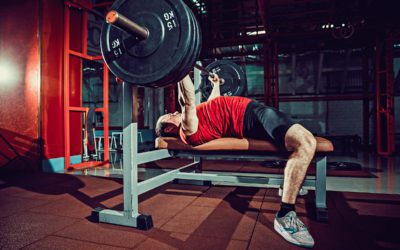68 Assistance Exercises for Olympic Weightlifting
TOPIC: Strength & Conditioning
In this article, I want to offer coaches and athletes a comprehensive approach to addressing some of the most common issues seen with developing weightlifters, CrossFit members/athletes, and general fitness and sports enthusiasts.

Written By
Mike Dewar
Mike holds a Masters in Applied Physiology from Columbia University and a Bachelors in Exercise Science from Bowling Green State University. He is an accredited Strength and Conditioning Specialist (NSCAS CSCS) from the National Strength and Conditioning Association and an Advanced Sports Performance Coach from USA Weightlifting (USAWL2).
Programs
Website
The below sections detail over 60 exercises geared specifically toward Olympic weightlifters and the development of positional strength, muscular development, and better movement integrity to enhance their lifting abilities and injury resistance.
Coaches and athletes can use the below exercise recommendations and workout programs in addition to their own programming. If you are a coach or athlete interested in being part of a community that discusses many topics of this nature, join me for more awesome articles and workout ideas in my community.
The below sections will offer coaches and athletes a wide variety of exercises to specifically:
- Improve positional strength and muscle mass for the snatch, clean, and jerk
- Increase muscle hypertrophy using weightlifting-specific bodybuilding exercises to develop the chest, back, shoulders, triceps, biceps, abdominals, and lower back
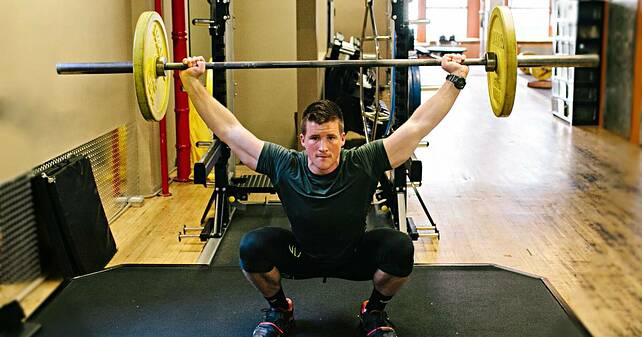
Weightlfting-Specific Exercises
The below exercises place a high emphasis on building muscle mass and positional strength, with little emphasis on high degree of technique (however, some do involve specific technique to the snatch).
It is important to note that these do not replace the clean and its direct variations within a training program and should not be the primary solution to common technique issues in the snatch.
Snatch-Specific Assistance Exercises
The below exercises place a high emphasis on building muscle mass and positional strength, with little emphasis on a high degree of technique (however, some do involve a specific technique to the snatch).
It is important to note that these do not replace the clean and its direct variations within a training program and should not be the primary solution to common technique issues in the snatch.
1. Snatch High Pull
The Snatch High Pull can help to increase upper body strength in the pull, pattern better elevation of the elbows, and force a lifter to maximize leg drive for fuller extension before the turnover phase of the snatch. Perform 3-5 sets of 3-5 reps at light to moderate loads.
2. Narrow Grip Overhead Squat
The Narrow Grip Overhead Squat can be used to increase upper back strength and overhead proper positioning while having the barbell locked out in the overhead squat/snatch positioning. Perform 3-5 sets of 5 reps with moderate loads. Focus on keeping elbows locked, hands closed, and trapezius muscles activated.
3. Snatch Press in Squat
The Snatch Press in Squat is done to help strengthen the upper back and body positioning at the bottom of the squat, which is helpful for lifters who press out snatches and/or fall forward at the bottom of the squat. Perform 3-5 sets of 3-5 reps with moderate loads.
4. Behind the Neck Snatch Push Press
The Behind the Neck Snatch Push Press is helpful for increasing muscle mass in the upper back, traps, shoulders, and arms specific to the snatch. This exercise mimics the exact dip and drive mechanics of the jerk, while also helping to instill proper barbell overhead mechanics necessary for the snatch lockout and receiving position.
5. Snatch Grip RDL
The Snatch Grip RDL can be done to strengthen the hamstrings, hips, lower back, and upper back specific to the snatch. The wider grip will force greater back arch (extension) and strength. Perform 3-5 sets of 5 reps with moderate to heavy loads.
Clean-Specific Assistance Exercises
The below exercises place a high emphasis on building muscle mass and positional strength with little emphasis on high degree of technique (however, some do involve specific technique to the clean).
It is important to note that these do not replace the clean and its direct variations within a training program and should not be the primary solution to common technique issues in the clean.
6. Clean High Pull
The Clean High Pull can be done to increase upper body pulling strength and assist in the third pull/turnover phases of the clean. This can be helpful for individuals who fail to secure a strong front rack in the clean and/or fail to elevate the barbell high enough in the pull. Perform 3-5 sets of 3-5 reps with moderate to heavy loads.
7. Sots Press (front press in squat)
The Sots Press (front press in squat) can be done to increase upper back and positional strength in the front squat, especially with those who collapse in the bottom of the clean. Perform 3-5 sets of 3-5 reps with light to moderate loads.
8. 45 Degree Bent Row
The 45 Degree Bent Row can help to increase lower/middle back, grip, and arm strength specific to the angles found in the second pull of the clean (explosion phase). Perform 3-5 sets of 5 reps with moderate to heavy loads.
9. Close Grip Overhead Press
Building bigger space for the barbell to sit in the front rack is key for proper positioning and comfort in the clean. This exercise builds out the anterior deltoid to aid in that growth. Additionally, this exercise can help improve tricep strength, which is key for lockout in the clean and jerk. Perform 3-5 sets of 5-8 reps with moderate to heavy loads.
10. Clean Grip RDL
The Clean Grip RDL can be done to strengthen the hamstrings, hips, lower back, and upper back specific to the snatch. The wider grip will force greater back arch (extension) and strength. Perform 3-5 sets of 5 reps with moderate to heavy loads.
Jerk-Specific Assistance Exercises
The below exercises place a high emphasis on building muscle mass and positional strength with little emphasis on high degree of technique (however, some do involve specific technique to the jerk).
It is important to note that these do not replace the clean and its direct variations within a training program and should not be the primary solution to common technique issues in the jerk.
11. Strict Press in Split Stance
12. Lunge in Split Stance
13. Jerk Recovery
14. Double Overhead Kettlebell Hold/Carry
General Strength and Hypertrophy
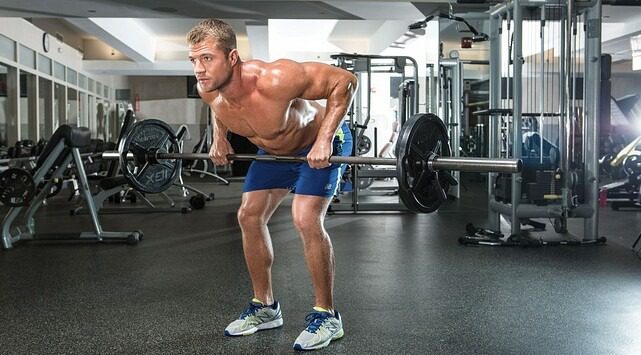
When looking to gain muscle mass, whether for the basis of strength development or to help a lifter gain muscle tissue for advancement in sport/weight classes, we typically want to train the largest muscle groups using compound lifts, like the exercises below.
Note that the below exercises include movements for the lower body; however, you should refrain from overindulging in excessive lower-body bodybuilding, as squatting and pulling (including RDLs) are generally sufficient in most Olympic weightlifting programs.
In the event a lifter wants to add more leg mass and strength, they should focus on adding one additional day of squatting (front or back) and/or select 1-2 movements to do per week (2-3 sets of 12-15 reps with moderate weight). Increased leg training volume is acceptable as long as that addition does not hinder recovery or training of the snatch, clean, and jerk.
The below movements can be done for 3 sets of either moderate reps (8-12) or higher rep-based training (15-20), using moderate to light weight. The emphasis should be on attaining “muscle pump” feeling to increase blood flow and accumulate metabolites within the muscle tissues necessary for hypertrophy.
Abdominals, Lower Back, and Hamstring Assistance Exercises
Backs and Traps
Warm-Up and Corrective Exercises
16. GHDs
19. Superman Holds/Reverse Hollow Rocks
20. Goodmornings
22. Planks (bodyweight or weighted)
23. Leg Raises
24. L-Sits
25. Sit-Ups and Crunches
29. Seal Row
31. Single Arm Row
32. Inverted Row (bodyweight or weighted)
33. Pull/Chin-Up (bodyweight or weighted)
34. Shrugs
Chest
Shoulders
Lower Body
Triceps & Biceps
65. Overhead Extensions
Sample 3-Day Assistance Bodybuilding Programs for Olympic Weightlifters
The below workouts are to be done after you complete your main Olympic lifting and strength lifts for that day. You may swap days to best match your current program (for example, I suggest not doing a lot of triceps and shoulders the day before a hard snatch or jerk session).
Strength in the Snatch: 3-Day Program
The program is geared for lifters who have a tendency to collapse in the overhead squat position, typically due to poor overhead mechanics and upper back mobility and strength.

Day 1
- Behind the Neck Snatch Push Press + Overhead Squat: 5 sets of (3+1) reps at 80-90% of snatch, or more
- Back Raises (bar on back): 4 sets of 8 reps
Day 2
- Snatch Press in Squat: 5 sets of 3-5 reps (controlled pause at top, keep heel and hips down)
- Seal Row: 4 sets of 8-10 reps
Day 3
- On the last day, you can do bench press, pull-ups, and this shoulder tri-set that includes Cuban presses, side raises, and bottoms up kettlebell presses.
Collapsing in the Clean : 3-Day Program
This program is for any athlete who has issues collapsing in the clean and jerk. It is geared towoard increasing your upper back strength, posture in the front squat, and overall muscular hypertrophy of the shoulders, back, and lower back.
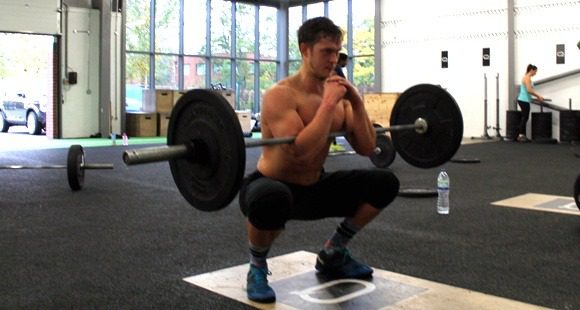
Day 1
- Clean Grip Overhead Squat: 5 sets of 4 reps
- Wide Grip Pull Up: 5 sets of 8-12 reps (not kipping, strict with pause at top)
Day 2
- Barbell Strict Overhead Press: 4 sets of 5 reps (controlled off chest, not bounced)
- Kettlebell/Dumbbell Waiters Carry: 4 sets of 15-20 yards per hand
Day 3
- Tempo 2121 Front Squat: 5 sets of 3 reps (use lifting straps in front rack to ensure full grip on barbell, high chest, elbows, and head)
- Sots Press (strict press in front squat) 4 sets of 3-5 reps (brief pause overhead, keep heels and hips down).
The Bodybuilding Weightlifter: 3-Day Program
This program is best for gaining general size, strength, and fitness. This can be done to help lifters gain fundamental strength and size necessary for better pressing, pulling and athletic performance.
Note: this can interfere with some weightlifting programs if fatigue is not monitored correctly, or if the lifter does too much. Therefore, be sure to make notes on soreness and how it correlates with training sessions later in the week.
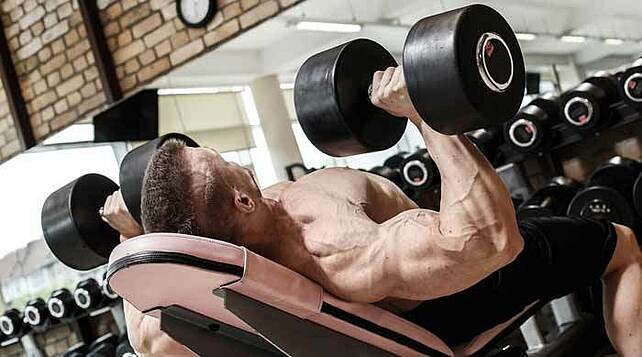
Day 1
- Dumbbell Bench Press: 5 sets to failure (Choose a weight that is near your 12-15 rep maximum for first set, and then do as many as you can across five sets with that weight).
- Strict Pull/Chin Up: 5 sets to failure
- Close Grip Push-Up: 100 reps for time
Day 2
- Trap Bar Deadlift: 4 sets of 8 reps with 50-60% of max (focus on back tension and lats, do not lose tension at floor). Load should not be heavy for hips and lower back. High volume pulling may interfere with lifts later in week, so be sure to go lighter than you think. This is to focus on the back muscles, not heavy pulling.
- Single Arm Row (Dumbbell, Meadows Row, Cable, etc.): 4 sets of 10-12 reps (slight pause at top of every rep, feel stretch, and minimize all momentum).
Day 3
- Leg Press: 3 sets of 8 reps (slow and controlled on way down, feel quad stretch)
- Calf Raise on Leg Press: 5 sets of 8-12 reps (slow and controlled on way down, feel calf stretch)
- Nordic Curls: 3 sets of 8 reps
Find Your Perfect Training Plan
Sometimes all you need to reach your destination on your fitness journey is an expert guide. Look no further, we've got you covered. Browse from thousands of programs for any goal and every type of athlete.
Try any programming subscription FREE for 7 days!
Related Articles
You May Also Like...
The Ultimate Guide to Lunges: Queen of all Glute Exercises
Your glutes are the largest muscle group in your body. They’re responsible for almost everything your legs do—walking, running, jumping, squatting, lunging, and just standing upright. As far as moving through space goes, strong glutes are the bedrock of overall...
A Beginner’s Guide to Steel Mace Training
Think you’ve mastered kettlebells? Meet the steel mace — the brutal, offset weapon that forces your body into three-dimensional stability, grip work, and rotational strength. Ancient tool. Modern performance.Written Byjesse grund Jesse Grund’s passion is simple: coach...
The Best Bench Press Warm Up Strategy
We get it. You’re pressed for time in the gym. But skipping the warm up is the surest way to underperform and risk injury. This 3D approach to your bench press warm up not only allows you to lift more weight, but also ensures the long-term health of your shoulder...
The Ultimate Guide to Lunges: Queen of all Glute Exercises
Your glutes are the largest muscle group in your body. They’re responsible for almost everything your legs do—walking, running, jumping, squatting, lunging, and just standing upright. As far as moving through space goes, strong glutes are the bedrock of overall...
A Beginner’s Guide to Steel Mace Training
Author: Jesse Grund
Mace training will make you a better mover without it’s not confining you to a fixed space or predetermined range of motion. Second, it’s an offset load with 80 to 90 percent of the weight in the head. You’re also constantly having to resist rotation, which creates greater core engagement.

Want more training content?
Subscribe
For Coaches
For Athletes
About
Support
Training Lab
Access the latest articles, reviews, and case studies from the top strength and conditioning minds in the TH Training Lab!
Made with love, sweat, protein isolate and hard work in Denver, CO
© 2024 TrainHeroic, Inc. All rights reserved.
For Coaches
For Athletes
About
Support
Training Lab
Access the latest articles, reviews, and case studies from the top strength and conditioning minds in the TH Training Lab!
Made with love, sweat, protein isolate and hard work in Denver, CO
© 2024 TrainHeroic, Inc. All rights reserved.


